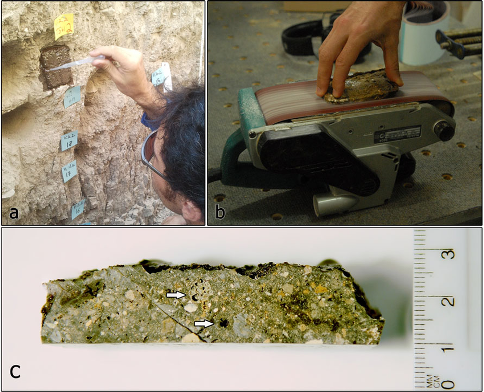SEDIMENTOLOGY
Our sedimentology services include core description, integration of core data and Petrophysical data, interpretation of Lithofacies and depositional model, sequence stratigraphic analysis, and paleogeographic reconstruction.
Thin-section preparation, description, point counting, and a range of specialized petrologic methods (SEM, XRD, and Fluid Inclusions) are also performed.
Our expertise ranges from Deep Water and Deltaic clastics to Carbonates, Evaporites and Shallow Marine deposits. Continental facies where we have extensive experience include Eolian, Fluviatile, and Lacustrine environments.
Detailed Lithologic Description
Detailed Lithologic Description for ditch cuttings, core samples, with log interpretation.
Core Description & Environmental Interpretation
Sedimentological core description will be undertaken at a scale of 1:40 / 1:50 or as required scale using your format or our industry standard Sedimentological core log.
Our log records :
Petrophysical data (K, ¢, grain density etc.), Lithology, Grain size, Grain sorting, Visual sedimentary structures, Interpreted sedimentary structures, Biogenic structures, Detrital mineralogy, Authigenic mineralogy, Physical structures, Indurations, Visual porosity, Facies/ lithologic descriptions
Thin Section Petrography and Diagenitic Modeling
Thin sections preparation from core samples, ditch cuttings or surface samples.
Thin sections are prepared using : High quality 1000 micron thick glass slides, Low refractive index epoxy resin for mounting, Vacuum impregnation, Ultra violet curing cover slip adhesive, Feldspar staining (sodium cobalt nitrite), Carbonate staining (potassium ferri-cyanide & Alizarin Red-S)
X - RAY DIFFRACTION (XRD ANALYSIS)
X - ray diffraction (XRD) is a basic tool in the mineralogical analysis of sediments, and in the case of fine grained sediments an essential one.
Although some clay minerals are evident in whole rock diffractograms, the most satisfactory method is to extract and separately analyses the clay fraction (usually defined as the less than 2 microns. If high levels of carbonate material or organic matter are expected these can be removed by acid attack (acetic acid) and hydrogen peroxide, respectively.

Grain size seive Analysis
This analysis is to perform a grain size analysis for selected samples and intervals in order to identify potential sandy intervals and their characteristic grain size distribution. Grain size sieve analysis data with weight and cumulative weight percentage plots will be presented.
Sieve analysis is undertaken on core samples which are thoroughly cleaned from the base mud and pore-filling hydrocarbons by using chloroform as a cleaning solvent. After cleaning, they were allowed to dry in low temperature oven. Samples were also soaked in distilled water.

PRE-SCREENING TESTS
This type of analysis helps the core Analysis for selecting the proper procedures of cutting the plugs, cleaning and drying systems to avoid any possible damage may occur prior to measurements.
The plug drilling, cleaning and drying programs are designed according to the nature of the rock, mineral composition, clay types content and their distribution among the pore system.





